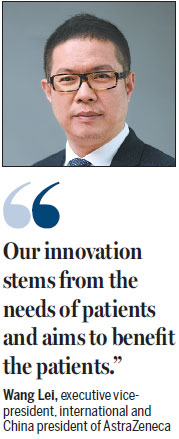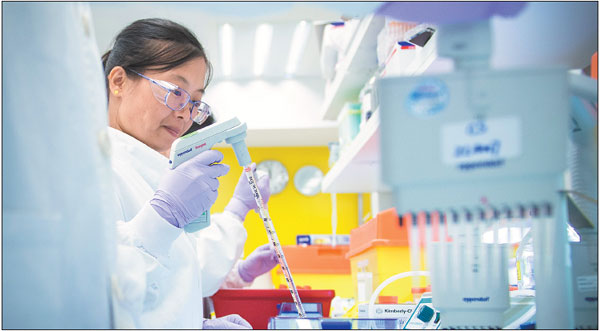AstraZeneca vows to build on deep relations, success in China
United Kingdom-based biopharma group AstraZeneca said it has huge plans for China - building on the success already achieved and deep ties established after a quarter century of doing business in the country.
The Cambridge-headquartered company said that in the past it had contributed substantially to improving the lives of Chinese patients, but it is now aiming even higher and has bigger plans.
It said these reflect the growing sophistication and demands of local people and the resolution by the country's top leadership to pursue innovation.
The FTSE 100 company has long been committed to bringing in innovative and affordable medicines to China and now is determined to expand its innovation capacity to advance the way treatments are delivered to patients.
Wang Lei, executive vice-president, international and China president of AstraZeneca, said comprehensive intelligent healthcare solutions could be realized via innovative drugs and the widespread use of the internet of things.
"AstraZeneca will be fully committed to participating in China's development and innovation drive, primarily in IoT cooperation with the Chinese government," Wang said.

These, he added, would develop intelligent healthcare solutions for various diseases and spread them further to countries involved in the Belt and Road Initiative.
"By doing that, the patient-centered solutions can benefit more patients, particularly in developing regions worldwide."
In March 2017, the company signed a strategic memorandum of understanding for IoT-based healthcare in Wuxi, Jiangsu province, with the Wuxi national high-tech zone, China Mobile Group Jiangsu Co Ltd and Swedish telecoms and technology group Ericsson.
The local government-backed partnership will promote the application of IoT technology in the diagnosis and treatment of respiratory, cardiovascular and digestive illnesses and tumors.
"The strategic partnership demonstrates how the government and industry can work together to create an innovative ecosystem for China's healthcare industry," said Leif Johansson, AstraZeneca's non-executive chairman of the board.
"We anticipate that the four sides will play important roles in promoting the development of IoT for healthcare in China."
The initiative aims to boost the use of IoT technology and big data to help improve the treatment experiences of patients, lower their risk, and advance overall healthcare efficiency, Wang said, adding that IoT technology would restructure the pharmaceuticals market.
Together with stakeholders including hospitals, wearable medical devices and the internet, AstraZeneca said it plans to build a new health ecosystem for all, integrated with all the necessary resources available from big data platforms.
For instance with the IoT technology, AstraZeneca has launched a mobile positioning service platform to help asthma patients locate nearby nebulizer centers for timely medical intervention.
Moreover, when the platform connects with weather and air pollution data, it can help with asthma risk alerts as well as self-protection for those with the condition.
"Our innovation stems from the needs of patients and aims to benefit the patients," Wang said. "Patient experience is crucial to raising awareness, early diagnosis and treatment and follow-up care."
To fuel and sustain innovation, the AstraZeneca China Commercial Innovation Center, located in the Wuxi high-tech zone, was inaugurated last June. It researches and develops innovative models in various therapeutic fields.
The center aims to accelerate the development and adoption of new IoT health solutions, and integrate resources from across society to create a medical ecosystem focused on patient benefits. The ultimate goal is to build an IoT-integrated health system that can manage the entire patient journey, from prevention to diagnosis, treatment and after-treatment care.
The IoT offers the chance to monitor the condition of patients in real time, and combine the information with the present medical system to provide more specific therapy for patients.
AstraZeneca, together with its partners, has applied IoT technology to disease diagnosis and treatment, concentrating on respiration, cardiology, metabolism and oncology, which are among the most urgent clinical needs of Chinese patients.
In December, the company signed an agreement with the Wuxi health and family planning commission and the China Cardiovascular Association, to establish a new model for chest pain treatment at the national Chest Pain Center in the city that can eventually be rolled out nationally.
The new treatment model is designed to create a citywide real-time interaction system based on IoT technology. It will follow evidence-based protocols that allow more rapid assessment and treatment of patients arriving at the emergency department with chest pains.
Wang said all the efforts will work to bring the innovative treatments to the right patients to achieve the best outcome possible.
On the drug research and development side, AstraZeneca announced in November a strategic joint venture with State Development & Investment Corp to form a jointly-owned, stand-alone company called Dizal Pharmaceutical.
It aims to accelerate the local development and discovery of innovative and affordable medicines for patients in China and around the world.
According to Wang, there are now four such new candidates in the pipeline that are expected to hit the Chinese market prior to Europe and the United States in the future. In addition, new target therapies for cancer will be introduced to China as well.
Last year, AstraZeneca got market approval from the China Food and Drug Administration for its lung cancer target treatment Tagrisso, under an accelerated pathway for innovative medicines. To improve patient access, a drug donation project in partnership with the China Charity Federation was launched to make the treatment affordable.
In 2016, the company reported $2.6 billion in sales in China, accounting for more than 10 percent of its global sales. Now, China is the fastest-growing market for AstraZeneca, and the company sees a more promising future in the country.
"We will continue toward our patient-centric goals of accelerating scientific innovation, to bring new medicines to patients and enhance China's R&D capabilities through diversified external partnerships," Wang said.
"All of these joint efforts will help meet unmet medical needs, and will ultimately be of great benefit to patients, which in the end is what drives our industry forward," he added.
UK Prime Minister Theresa May is visiting China together with a British business delegation, and AstraZeneca is on the list. The healthcare industry is acting as a fast-growing engine of international trade and commerce between China and the UK.
"We are proud of our 25-yearlong presence here and our contribution to patient health in China," Wang said.
"And we are indeed very excited to see more win-win achievements through the prime minister's visit to China, with AstraZeneca taking an active part in the development of China-UK relations as we always do."
|
A scientist performs an experiment at an AstraZeneca lab.Provided to China Daily |
(China Daily 02/02/2018 page18)















